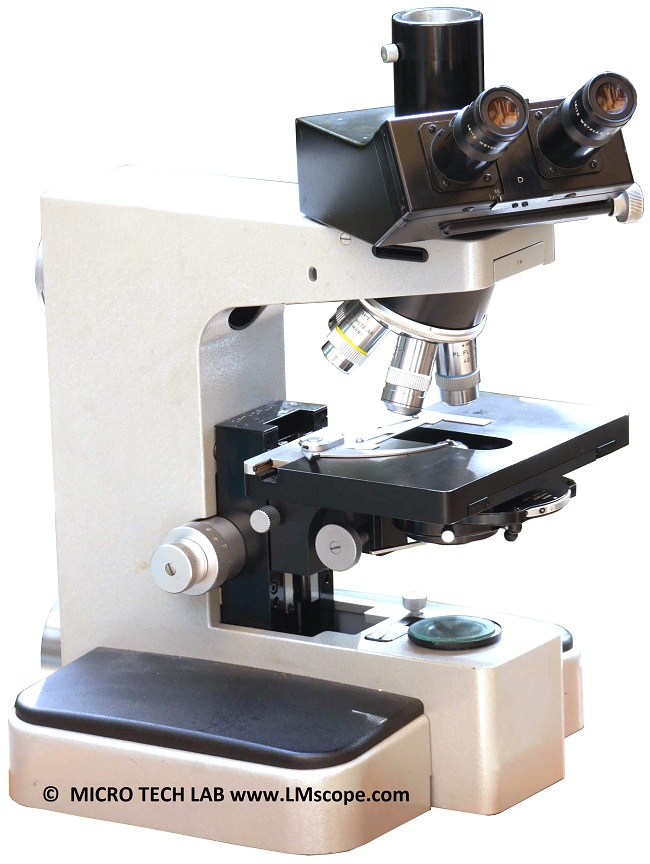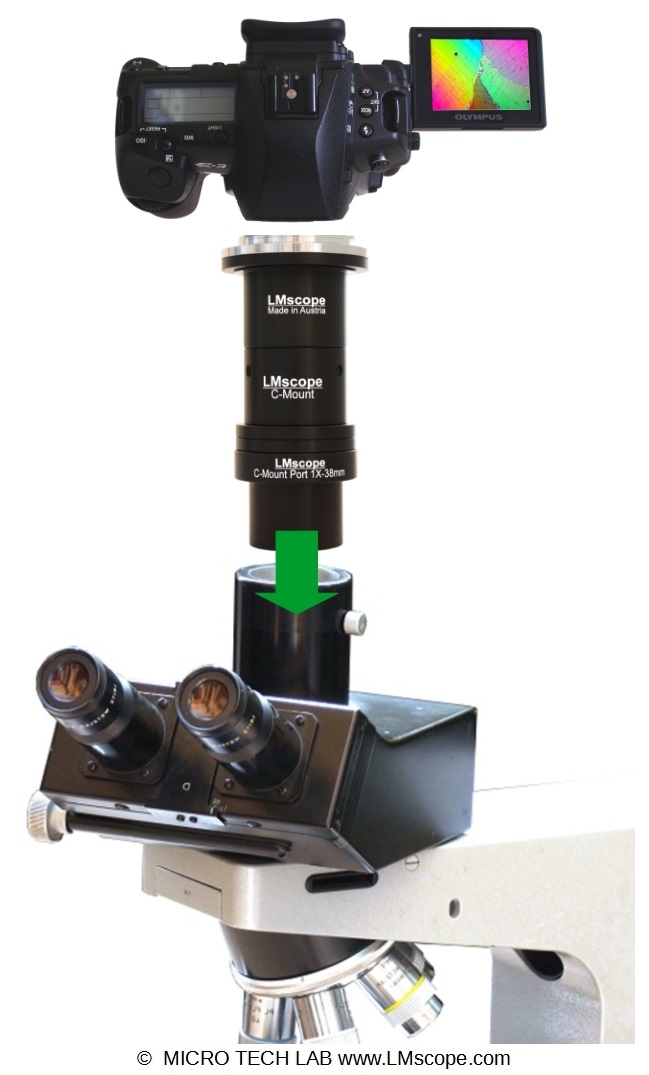

Attaching modern digital cameras to the Leitz Orthoplan: with our LM microscope adapter with built-in precision optics, you can take high-quality images through this venerable microscope
The Orthoplan, Leitz’s flagship research microscope, was introduced in 1966 and continued in production essentially unchanged until 1991. The Orthoplan is still used at universities and other research facilities around the world today, and, thanks to our LM digital adapter solutions, it can be connected to modern digital cameras in just a few easy steps.

As one of the first microscopes ever, the Orthoplan is equipped with movable eyepieces with an internal diameter of 30 mm, resulting in a larger field of view (28 mm). Today, the eyepieces of all modern microscopes have this dimension. The interpupillary distance is adjustable from 55 to 75 mm.
The Orthoplan system features a modular design and is capable of the following methods of illumination: brightfield, phase contrast, phase contrast fluorescence, darkfield, interference contrast and fluorescence.
Because the various pieces – nosepiece with 1 to 6 positions, body tube, condenser, stage and lamp house – can simply be changed out, the microscope offers a high level of flexibility. The objectives are corrected for a tube length of 170 mm: In this case, the lens does not produce an intermediate image, but the light emerges from the lens as a parallel beam path. This optical design (infinity-corrected), which was new at the time, allows for more flexible use of the space inside the stand because optical accessories (such as filters, phase rings or prisms) can be placed into the beam path without affecting magnification or performance. The finite microscope design (standardised tube length of 160 mm), which was common at the time, would not have provided enough room for adding optical accessories into the light path. However, most “finite” 160 mm objectives can be used on the Orthoplan without much impact on the image quality.
A variety of body tubes are available for the Orthoplan. The FSA-GW tube supports the 30 mm eyepieces and has a built-in beam splitter that transmits 80% of the light to the phototube and 20% to the eyepieces for observation. The photo port of the trinocular head has an internal diameter of 38 mm – a standard dimension that is suitable for our products.

Depending on the sensor format of the camera, we offer adapter solutions that provide a large field of view and a high level of image quality. Our product range also includes a C-mount adapter.
Its sturdy construction makes the Orthoplan a good fit for photomicrography applications. Thanks to the quality workmanship Leitz put into the microscope, this “dinosaur” can still hold its own, even in the digital age. With our adapter solutions, which have built-in precision optics, the Leitz Orthoplan can be connected to the latest and most advanced digital cameras, such as mirrorless system cameras, digital SLR cameras, C-mount cameras, fluorescence cameras, dedicated microscope cameras and high-speed camera.
As an alternative to the photo port, the camera can also be attached to the eyepiece tube of the microscope. Simply remove one eyepiece and plug the camera, together with the adapter, into the tube (standard internal diameter: 30 mm). The image quality is equally good with both solutions, but if you think of workflow and ergonomics, using the dedicated photo port to connect the camera is definitely the preferred option.
05.06.2023Photography:
Fitting the microscope to digital single-lens reflex (DSLR), mirrorless interchangeable-lens cameras (MILC ), digital single-lens mirrorless (DSLM) or C-mount cameras is easy with our LM digital SLR adapters, which feature a plan achromatic optical system. Our products make it possible to capture top-quality microscope images. To help you select the adapter that is right for your camera, we have set up an online configurator on our website. You can also email us – ideally with attached photographs of your microscope.
Modern DSLR and single-lens mirrorless (DSLM) offer the latest technology and are generally very well suited for microscopy applications. Most of them can be controlled remotely via PC/Mac. Because of their high sales volumes, they offer an excellent price/performance ratio compared to special-purpose microscope cameras.
Features of top DSLR and single-lens mirrorless cameras (DSLM):
- Large, powerful full-frame sensors (36 x 24 mm)
- Sensor resolution of 61 megapixels or 240 megapixels with Pixel Shift technology
- High light sensitivity (ISO 400,000+)
- Extensive dynamic range (up to 15 aperture stops/f-stops)
- Short exposure times (1/8000 second) up to 1/32,000 seconds using the digital shutter
- 4K Ultra HD or 8K Ultra HD video function
- Live video capture on external monitors in ultra HD quality
In most cases, these cameras are significantly more powerful than microscope cameras with smaller sensors (1/2" or 2/3"). On our website you will find our current camera recommendations and a camera ranking which is specifically tailored to microscopy applications.